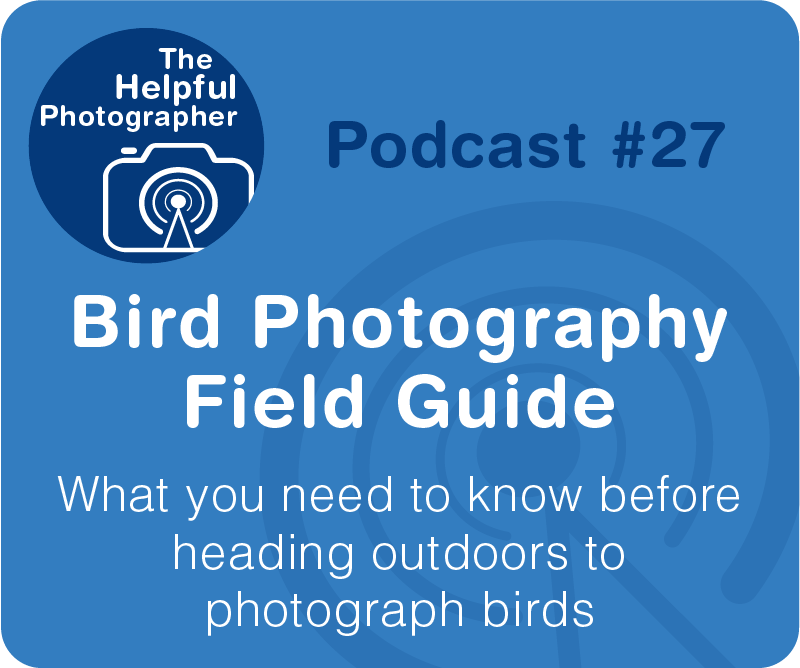Bird Photography Field Guide
Photo Tips Podcast:Bird Photography Field Guide #27

iTunes
Google
Spotify
Tune In
Stitcher
RSS
Pandora
Bird Photography Field Guide
Zim: Today I’ve asked Alison Pretious to return to the podcast to answer my questions about heading out into the field to do some bird photography. Allison is our resident ask a pro tech and a member in good standing with the Royal Photographic Society. Hey Alison how are you doing?
Alison: Hi Zim, good thank you. Have you been out shooting the birds?
Zim: Well I've tried but my bird feeder has not been very successful because I can't put my bird feeder in the right spot; I live in an urban environment so things aren’t going great. I think my next option here to shoot birds is I'm going to have to go find a wildlife refuge nearby and spend some time there. That's why I called. I'm wondering if you can give me some advice with regards to what I need to know as I head out doors.
Alison: I suppose one of the important things is your clothing, if you have a good set of clothing that mingles in with the environment because bright colors, it's no good going out into green and brown environment in their natural habitats in a red jacket or yellow jacket you need to blend in and you need to be silent so the clothing itself technically has to silent.
Zim: So I can't make a lot of noise otherwise I’ll scare the birds right?
Alison: You will.
Zim: That makes sense. But with regards to the color of the clothes I guess that sounds like I need to get some camo gear?
Alison: Well I wear a brown jacket or green jacket. But yeah ideally camo would be best. I would also take a black sack with me as well because if you're crawling around the ground it’ll keep you dry.
Zim: A black sack you mean a large black garbage bag?
Alison: Yea because you want to be able to lay down and get some shots because hopefully they'll be not too far in front of you.
Zim: Good deal what else do I need to know?
Alison: You need to keep quiet really, you need to take some drink and food because you're gonna be out there a while. It’s not just walk out, lay down and shoot a few birds you’ve got to wait for them. You’ve got to suss out their environment. They’re there for a reason. They’re looking for the berries and the insects.
Zim: So how much time should I plan as I head out to shoot?
Alison: I would I would at least four hours and I would head out first thing in the morning or when it’s starting to get dusk. Because that's when the birds are most active. Morning and evening.
Zim: Okay so I guess if I'm doing a morning shoot I got to be out there probably an hour before sunrise just to set up my position right?
Alison: Yea, I would think so.
Zim: And I guess if I'm shooting towards the end of the day, I guess about four hours before the sunset?
Alison: It depends on the weather really. If the weather has been bad in the morning and then they go out for longer in the evening.
Zim: Okay so they tend to hunt in the morning or in the evening for their food but if the weather's bad in the morning they'll be more active in the evening because they didn't get their shopping done so to speak in the morning.
Alison: That's correct yeah.
Zim: I guess I’m gonna be out there four to six hours I ought to bring my lunch or dinner but what about feeding the animals themselves?
Alison: In their natural habitat you know they’re there because naturally there’s food there for them. So unless you go back time and time again, and baiting the same food every time so they get used to it, like when they get used to it in your back yard. I wouldn’t do that. And it's not considered wildlife photography if you bait the birds.
Zim: Well you know I want to hedge my bet if I can. So I'm reminded of the previous conversation where you felt the one most important things that a bird photographer can do is to do the research about the birds’ habits. It goes along with what you just said which is birds are going to be where they feed, so you need to know where that food is so that you can get to those birds.
Alison: That’s it exactly, yeah…in a nutshell.
Zim: Thus far we've talked about going out and being comfortable, I have to have the right clothes not only to stay warm but also to blend in with the environment having my lunch so that I don't starve out there and I can keep going. What else do I need to know?
Alison: A pair of binoculars would be useful because often I hear the birds. I’m listening for the bird calls. Certain birds make certain noises. And going out there time and time again you soon know what their different calls are and you then know where to look. Like a King Fisher fishing near a river; you hear a high pitch, a very high pitch. And you know it’s a King Fisher. The more you can learn the better the experience will be. And the more photos you will be pleased with. As I did say before, you need a really good bird book.
Zim: Okay so what about camera equipment what do I need to bring as far as camera equipment is concerned?
Alison: Bring a bean bag to rest your camera on. Be it in a hide or what do you call it in America?
Zim: All we call them blinds.
Alison: Blinds, yeah. When you’ve opened a window. There are letterbox windows in the hides or blinds, it's nice to be able to rest your camera on a bean bag, so you can change the angle very quickly. You don't want to damage your lens. But I always put my lens with a camouflage cover. You can buy neoprene cover for various size lenses. And there again it would be in an outdoor store, they sell that type of thing for your camera.
Zim: Let's talk about this blind, you call them a hide. What is this thing you're talking about?
Alison: If you already know nature reserve that has hides or blinds there, it would be like a wooden shed. But I have actually got a pop up hide. So it literally just pops up like a little tent; I get in there, it’s got a couple of windows, one waist high and one low down. And then I just stay quiet, I’m looking and listening the whole time for the birds.
Zim: Okay so this sounds a lot like what hunters do too. They also have these little pop up devices that they sit inside and I guess it's really cool because it shelters you from the environment. So it's not so cold but it also hides you in the environment as well and it has a little window so that you can stick your, I guess your gun or in this case our cameras out them. And just wait for the birds to come by.
Alison: That’s right, yea.
Zim: So how many millimeters are you shooting?
Alison: I’ve got a seventy to two hundred that I’m comfortable with because I can carry it easily as well as my other kit that I’m carrying. So I can walk quite a distance with that lens. And hopefully get closer into the birds. Sometimes I take my four hundred out. But I can’t carry that very far because it’s too heavy because I have that on a monopod. So I tend to take those to the bird sites that don’t involve too much walking.
Zim: I would have thought that you would have been shooting four hundred or a longer but you're saying you're shooting seventy to two hundred, I mean that seems awfully short to me.
Alison: That’s why you need all these things, your camouflaged clothing, your silent clothing, your pop up hide. You need all these things so you can get in closer and then stand a good chance of getting a quality picture.
Zim: Wow, so this is getting a little bit tougher. I’m beginning to understand. I was really thinking to myself you know get the big four hundred millimeter lens out there and just shoot away. But if you're shooting two hundred millimeters that means you really got to go out there and just sit for a while and wait for them to come by because you're so close to them.
Alison: That's exactly it and that's why we need to be quiet and blend in with their environment.
Zim: So it sounds like we have a list. We need quiet camo colored clothing, some food to keep us comfortable out there for four to six hours, a blind to blend into the environment, some binoculars and a seventy to two hundred millimeter lens. Is there anything else we need to know?
Alison: I think we basically covered it all. You just gotta remember: blend in, patience and practice will reap its rewards. Because it does take practice. And just keep studying the birds. You know, keep looking at the books. Keep looking at the varieties. Read about the different habitats. Try to listen to some bird calls. When you’re out and about just listen, listen to what you can hear and try to match the call with the bird. There are cd’s available, you can learn the bird calls.
Zim: Great so I'm gonna head out and do some shooting and see how it goes. I'll call you in a few weeks. I'm quite sure I'll have some questions about how to shoot birds.
Alison: Yeah I’ll look forward to seeing your results.
Zim: All right take your Allison.
Alison: You too Zim, stay safe!
Zim: Will do.











